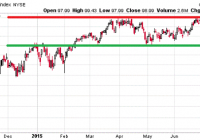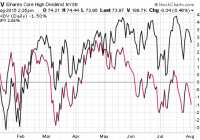
Summary Despite weak retail sales forecasts, the Direxion Daily Retail Bull 3x ETF has risen on Amazon’s higher earnings like a drone for home delivery. The Fidelity Select Retailing Portfolio has also soared, on the back of strong retailers, and offers an unleveraged exposure to this sector. However, other ETFs in the retail sector, such as the XRT Retail SPDR is mired in a consolidation. A handful of retail stocks are the key to this out-performance. As key retailers get stronger can the market be far behind? Introduction: Lowered Retail Sales Forecasts The National Retail Federation recently lowered their forecast for the 2015 calendar year from +4.1 percent to +3.5 percent (see reference 1). They also lowered their back-to-school spending by as much as -9 percent (see reference 2). These lowered forecasts are seen in the performance of say the SPDR S&P Retail ETF (NYSEARCA: XRT ) , which is stuck in a trading range between approximately 96 and 102 (see Figure 1). (click to enlarge) Figure 1: The SPDR Retail ETF is stuck in trading range, consistent with lack luster retail sales forecasts. (Chart courtesy StockCharts.com) AMZN, PCLN Report Strong Earnings In the current earnings season, Amazon (NASDAQ: AMZN ) reported a quarterly EPS of $0.19 per share, versus a consensus of a loss of -$0.15 per share (reference 3), pushing sharply higher (see Figure 2). Then Priceline (NASDAQ: PCLN ) pushed to all time highs on its earnings report (see reference 4), coming it at $11.57 versus an expectation of $11.10. Clearly, some retailers have something up their sleeve. (click to enlarge) Figure 2: Amazon has soared on higher earnings (Chart courtesy StockCharts.com) (click to enlarge) Figure 3: Priceline pushed to all time highs on earnings (Chart courtesy StockCharts.com) Select Retailers Now Trending Strongly The markets have rewarded the improved earnings by pushing these stocks higher. Their relative out-performance can be measured using the table below (see Figure 4). The absolute medium-term trend strength of the Fidelity Select Retailing Portfolio ( FSRPX) and the Direxion Daily Retail Bullish 3x ETF ( RETL) put them in the top tier of all funds. They are much stronger than the broader S&P-500 index which is only at 52, and are soaring compared to the Apple (NASDAQ: AAPL ), the other retailing giant. (click to enlarge) Figure 4: The absolute trend strength of FSRPX and RETL puts them in the top tier. Note how they are much stronger than retailing giant AAPL, and the S&P-500 index itself. (Data courtesy ETFmeter.com) Leveraged and Un-leveraged Opportunities It is rare to find two such similar funds offering both leveraged and unleveraged investing opportunities into a particular sector with such near perfect correlation. The Fidelity Select Retail portfolio is unleveraged, and has good liquidity. RETL is leveraged, but has less liquidity. The leverage can cut both ways, should the market correct, and hence many might prefer the FSRTX to the RETL for further analysis. XRT is another unleveraged way to track the fortunes of retailers going into the fourth quarter with good liquidity and without the volatility that leverage can bring. Portfolio Weights Secret to RETL and FSRPX success RETL has a very large exposure to AMZN stock (see Figure 5 or reference 5). Almost 41% of the fund is in just three stocks. Even Home Depot (NYSE: HD ) is helping by breaking out to new highs. The portfolio for FSRPX is similar, though they do not give the same breakdown. About 67% of the FSRPX is in Home Depot, Amazon, Priceline, TJX companies (NYSE: TJX ) , O’Rielly Automotive (NASDAQ: ORLY ), G III (NASDAQ: GIII ), Lowes (NYSE: LOW ) and Ross Stores (NASDAQ: ROST ). So, the key to the success of these two funds is their portfolios (see Figure 6). A detailed comparison to other ETFs in the sector and other technical data are available at reference 6. Figure 5: The most recent portfolio weights for RETL (see reference 5) show a large position in Amazon, which has helped its performance. (click to enlarge) Figure 6: The returns of RETL and FSRPX have near perfect 0.99 correlation over the long-term. Thus, you can use the less leveraged option with similar approaches to this sector. (Chart courtesy StockCharts.com) Looking Ahead All retailers are clearly not the same. Some have harnessed technology to their competitive advantage. Traditionally, the last quarter of the year is the best quarter for retail earnings. So better days are ahead for the strongest retailers, as the economy picks up in the second half. Plus, this sector offers both unleveraged and leveraged funds to suite your comfort level. As key retailers strengthen, can the rest of the market be far behind? References National Retail Federation revises down 2015 US retail sales forecast Retail sales forecasts: Something doesn’t add up NASDAQ AMZN Earnings NASDAQ PCLN Earnings Direxion Investments ETFmeter Disclosure: I/we have no positions in any stocks mentioned, and no plans to initiate any positions within the next 72 hours. (More…) I wrote this article myself, and it expresses my own opinions. I am not receiving compensation for it. I have no business relationship with any company whose stock is mentioned in this article.

